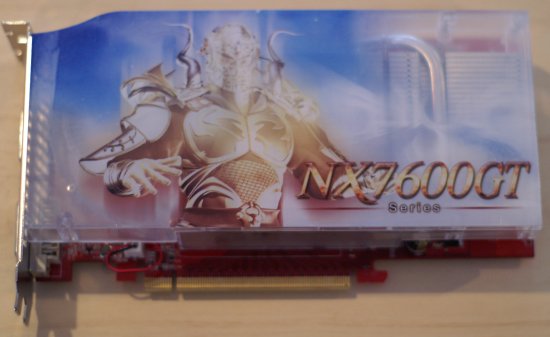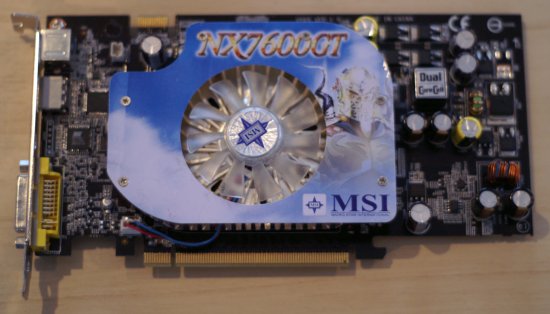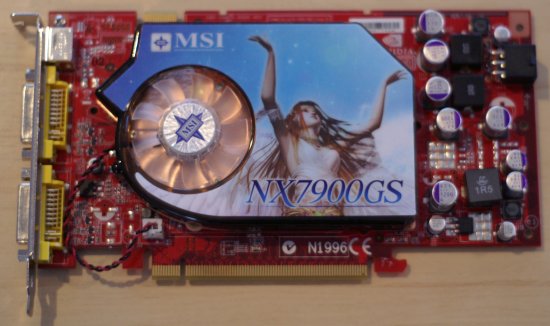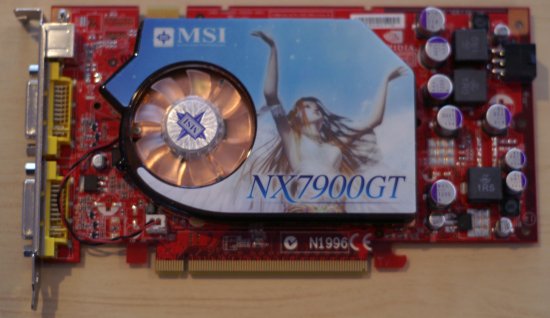NVIDIA and ATI HDCP Compatible Graphics Cards Roundup
by Josh Venning on November 16, 2006 12:00 AM EST- Posted in
- GPUs
MSI GeForce NX7600 GT
For this HDCP card roundup, MSI provided us with a total of four cards. The first is the MSI NX7600 GT which comes factory overclocked at 580/750MHz (core/mem). Interestingly, this card has a very large heat sink that covers the entire card and takes up a second slot on the case. The NX7600 GT has two DVI ports, as well as an S-Video out for connection to a TV.

MSI GeForce NX7600 GT Diamond Plus
The next card by MSI is a much newer and sleeker version of the NX7600 GT, the GeForce NX7600 GT Diamond Plus. This version of the 7600GT adds HDMI and component video outputs. It also adds an S/PDIF audio input for running audio through the HDMI connection. As the image below shows, the card is also much slimmer than the previous NX7600 GT, only requiring a single PCI slot on the motherboard. This fact, along with the HDMI port, might make this version more desirable. However, because the Diamond Plus is only clocked at reference speeds (560/700), those wanting more gaming performance might opt for the non-HDMI version of the two. Both of these cards (like most 7600 GT cards) draw their power through the board rather than using an external power connection.

MSI GeForce NX7900 GS
The third card we have from MSI is the GeForce NX7900 GS. The 7900 GS is a midrange card that provides decent performance for its price. This version of the card by MSI looks very similar to NVIDIA's reference design, with MSI's custom graphics on the heatsink. The card comes with two DVI connections, as well as an analog connection with component video support. Some versions of the MSI GeForce NX7900 GS also come with a factory overclock of 500MHz on the core and 700MHz on the memory, but the one we have is reference clocked at 450/660.

MSI GeForce NX7900 GT
The last card from MSI that we have is the MSI GeForce NX7900 GT. Unlike the NX7900 GS, our NX7900 GT did in fact come to us with a factory overclock of 500/765 over the standard 7900 GT clock of 450/660. Like the NX7900 GS, this card looks much like the reference design, with the standard HSF with the MSI logo on it. The card also has two DVI connectors and an analog video adapter (S-Video, Composite, and Component outputs) like the NX7900 GS.

For this HDCP card roundup, MSI provided us with a total of four cards. The first is the MSI NX7600 GT which comes factory overclocked at 580/750MHz (core/mem). Interestingly, this card has a very large heat sink that covers the entire card and takes up a second slot on the case. The NX7600 GT has two DVI ports, as well as an S-Video out for connection to a TV.

MSI GeForce NX7600 GT Diamond Plus
The next card by MSI is a much newer and sleeker version of the NX7600 GT, the GeForce NX7600 GT Diamond Plus. This version of the 7600GT adds HDMI and component video outputs. It also adds an S/PDIF audio input for running audio through the HDMI connection. As the image below shows, the card is also much slimmer than the previous NX7600 GT, only requiring a single PCI slot on the motherboard. This fact, along with the HDMI port, might make this version more desirable. However, because the Diamond Plus is only clocked at reference speeds (560/700), those wanting more gaming performance might opt for the non-HDMI version of the two. Both of these cards (like most 7600 GT cards) draw their power through the board rather than using an external power connection.

MSI GeForce NX7900 GS
The third card we have from MSI is the GeForce NX7900 GS. The 7900 GS is a midrange card that provides decent performance for its price. This version of the card by MSI looks very similar to NVIDIA's reference design, with MSI's custom graphics on the heatsink. The card comes with two DVI connections, as well as an analog connection with component video support. Some versions of the MSI GeForce NX7900 GS also come with a factory overclock of 500MHz on the core and 700MHz on the memory, but the one we have is reference clocked at 450/660.

MSI GeForce NX7900 GT
The last card from MSI that we have is the MSI GeForce NX7900 GT. Unlike the NX7900 GS, our NX7900 GT did in fact come to us with a factory overclock of 500/765 over the standard 7900 GT clock of 450/660. Like the NX7900 GS, this card looks much like the reference design, with the standard HSF with the MSI logo on it. The card also has two DVI connectors and an analog video adapter (S-Video, Composite, and Component outputs) like the NX7900 GS.











48 Comments
View All Comments
rnemeth - Friday, December 1, 2006 - link
I personally think this article was extremely on point with the direction of media components in general. I think there will be many people out there, like me, who are planning on the convergence of the Media Center PC & Gaming PC. Vista (Ultimate) will bring Media Center to the masses and why shouldn't you be able to play your favorite DX10 "Game for Windows" on your big HDTV as well?
This article is ahead of its time. HDPC/DRM/HDMI/DVI/BR/HD-DVD/HDTV is all in the early stages. In the future, you will be able to buy or rent your high-def movie by downloading it to your PC with DRM finally figured out. This review shows us that it is not all there yet, but gives us an idea who is doing what, and what we need to look for.
You mentioned in the beginning of the article that you were looking for feedback to see how interested your audience is on this subject... count me as 1.
thejez - Sunday, November 26, 2006 - link
HDCP is a joke... look at how hard it is to understand and get this stuff running... not to mention you have upgrade all your hardware?? lol and who watches movies on their PC anyway?? do you people really sit huddled over your keyboard watching movies?? Why not invest in some better equipment for the family room and watch movies they way they were intended....but the difficulty in setting all this up makes it even more important that hdcp has already been cracked... i wouldnt let the movie industry tell you your hardware isnt good enough to buy their content... just buy what you want and "work" around the issue later... the cracks are only getting better.... we'll see HD-DVD Shrink soon enough...
KalTorak - Monday, November 20, 2006 - link
Careful - it's not safe to assume that higher bitrate content is more computationally difficult to decode than lower bitrate content. [In fact, I suspect they're weakly correlated the other way - lower bitrate is harder.]DerekWilson - Monday, November 20, 2006 - link
ahh ... very interesting ...it would make sense to me to say that both are true.
In the case where low bitrate means more aggressive high quality encoding, i absolutely see your point. But low bitrate can also mean lower quality (less information) at the same level of encoding -- in these cases lower bitrate will be easier to decode.
Thanks for pointing this out.
Badkarma - Monday, November 20, 2006 - link
Hi Derek,Can you comment on HD audio formats like Dolby TrueHD and DTS-HD for the HTPC? I know Bluray has yet to use these formats but how about HD-DVD on the HTPC. From what I understand, you could get these formats outputted via analog output on your soundcard, but I'm interested in HDMI. I know some of the HDMI video cards you reviewed have SPDIF passthrough via HDMI, however SPDIF cannot carry Dolby Digital +, TrueHD, or DTS-HD, it will only output DTS or DD. I'm holding back on a HDCP video card because HD audio is an important part of HD movies.
Thanks.
Ajax9000 - Sunday, November 19, 2006 - link
p.13 "Both the 8800 GTX and GTS are fully HDCP compatible, and HDCP is enabled through both DVI ports" p.22 "Some of the cards, like the HDMI Gigabyte 7600 GS and ASUS EN7600 GT, were only able to play our Blu-ray movies over HDMI and not through the DVI port. Conversely, we found that with our MSI NX7600 GT Diamond Plus, the Blu-ray content wouldn't play through the HDMI connection but it would through the DVI port."OK, so which cards (other than the 8800s) could do HDCP over both ports?
----
p.19 "The end result is that an NVIDIA card with more pipelines that is better at 3D performance will not necessarily be better at video decoding."
In other words overclocking (say) a 7600 is likely to give as good or better HD video results than using (say) a 7950GX2?
----
p.20 "In the future, we could see power consumption go down with acceleration enabled. As graphics hardware is better suited to processing video than a CPU, efficiency should go up when using hardware acceleration."
The results for the 9750GTs already seem to show this 147W average non-accelerated >> 142 for EVGA & PNY (although Gigabyte > 148W).
Adrian
chucky2 - Friday, November 17, 2006 - link
...can we get it added to these results just for comparison?Also, you don't happen to know when that'd be, would you? :)
Chuck
BigLan - Friday, November 17, 2006 - link
I noticed that in the cpu utilisation tests you said it was around 51% for no acceleration - was this because the player software is single threaded and so only used one core?Also, is click encoded in h264, or mpeg2 like the initial bluray discs?
DigitalFreak - Friday, November 17, 2006 - link
Now that the Xbox 360 HD-DVD drive is available and is proven to work with a PC, any chance on doing another round-up "real soon now" using HD-DVD? I'd really love to see the numbers for VC1 and H.264 decoding.Still amazed that the lowly X1600 card spanked all Nvidia cards but the G80 boards in CPU utilization.
Good job guys.
DigitalFreak - Friday, November 17, 2006 - link
BTW, the new releases from Fox on Blu-Ray use the H.264 codec. Behind Enemy Lines, Fantastic 4, etc. I think Behind... is already out.